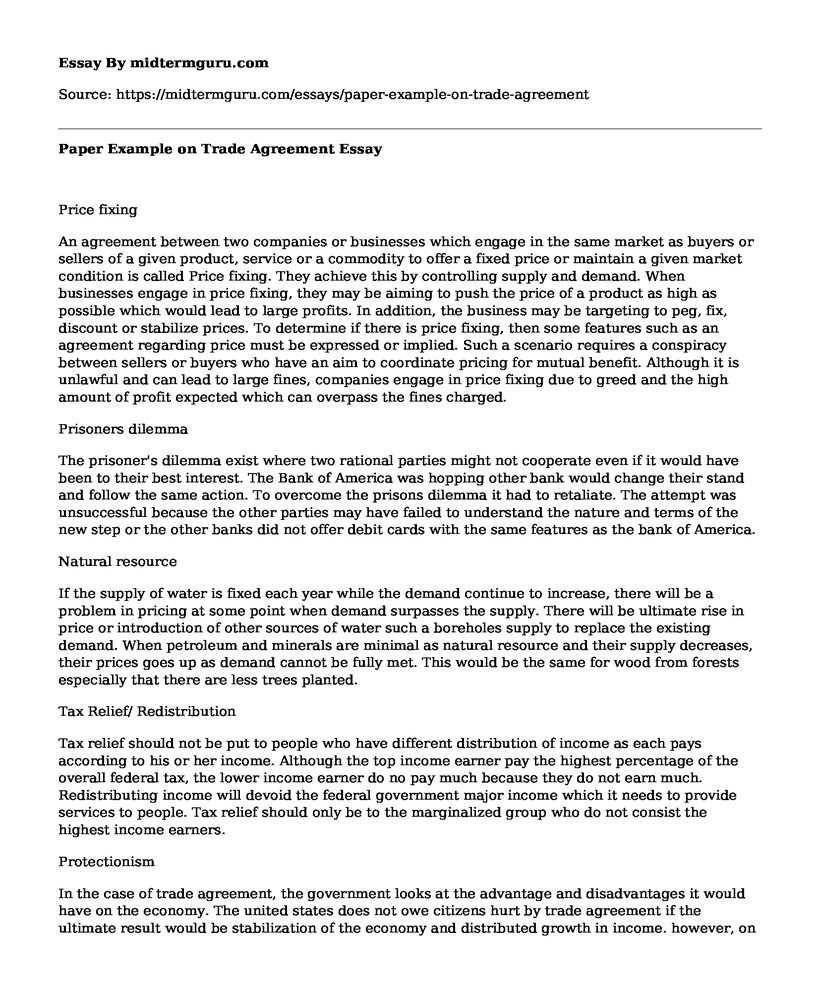Price fixing
An agreement between two companies or businesses which engage in the same market as buyers or sellers of a given product, service or a commodity to offer a fixed price or maintain a given market condition is called Price fixing. They achieve this by controlling supply and demand. When businesses engage in price fixing, they may be aiming to push the price of a product as high as possible which would lead to large profits. In addition, the business may be targeting to peg, fix, discount or stabilize prices. To determine if there is price fixing, then some features such as an agreement regarding price must be expressed or implied. Such a scenario requires a conspiracy between sellers or buyers who have an aim to coordinate pricing for mutual benefit. Although it is unlawful and can lead to large fines, companies engage in price fixing due to greed and the high amount of profit expected which can overpass the fines charged.
Prisoners dilemma
The prisoner's dilemma exist where two rational parties might not cooperate even if it would have been to their best interest. The Bank of America was hopping other bank would change their stand and follow the same action. To overcome the prisons dilemma it had to retaliate. The attempt was unsuccessful because the other parties may have failed to understand the nature and terms of the new step or the other banks did not offer debit cards with the same features as the bank of America.
Natural resource
If the supply of water is fixed each year while the demand continue to increase, there will be a problem in pricing at some point when demand surpasses the supply. There will be ultimate rise in price or introduction of other sources of water such a boreholes supply to replace the existing demand. When petroleum and minerals are minimal as natural resource and their supply decreases, their prices goes up as demand cannot be fully met. This would be the same for wood from forests especially that there are less trees planted.
Tax Relief/ Redistribution
Tax relief should not be put to people who have different distribution of income as each pays according to his or her income. Although the top income earner pay the highest percentage of the overall federal tax, the lower income earner do no pay much because they do not earn much. Redistributing income will devoid the federal government major income which it needs to provide services to people. Tax relief should only be to the marginalized group who do not consist the highest income earners.
Protectionism
In the case of trade agreement, the government looks at the advantage and disadvantages it would have on the economy. The united states does not owe citizens hurt by trade agreement if the ultimate result would be stabilization of the economy and distributed growth in income. however, on ethical ground, then the government owes them some stabilization of their lives and improving their incomes and that why an educational program would be important .
Cite this page
Paper Example on Trade Agreement. (2021, May 24). Retrieved from https://midtermguru.com/essays/paper-example-on-trade-agreement
If you are the original author of this essay and no longer wish to have it published on the midtermguru.com website, please click below to request its removal:
- Professional Sports Ticket Prices and the Market - Essay Example
- The Maritime Law and The Hague-Visby Rules - Paper Example
- Calculating the Cost of Equity - Paper Example
- Price Elasticity of Demand - Essay Sample
- Empowering Employees: Strategies for Leader Success - Essay Sample
- U.S. Immigration: Assimilation, Culture, and Economics - Essay Sample
- Silk Road: Ancient Trade Route Linking East & West - Research Paper







